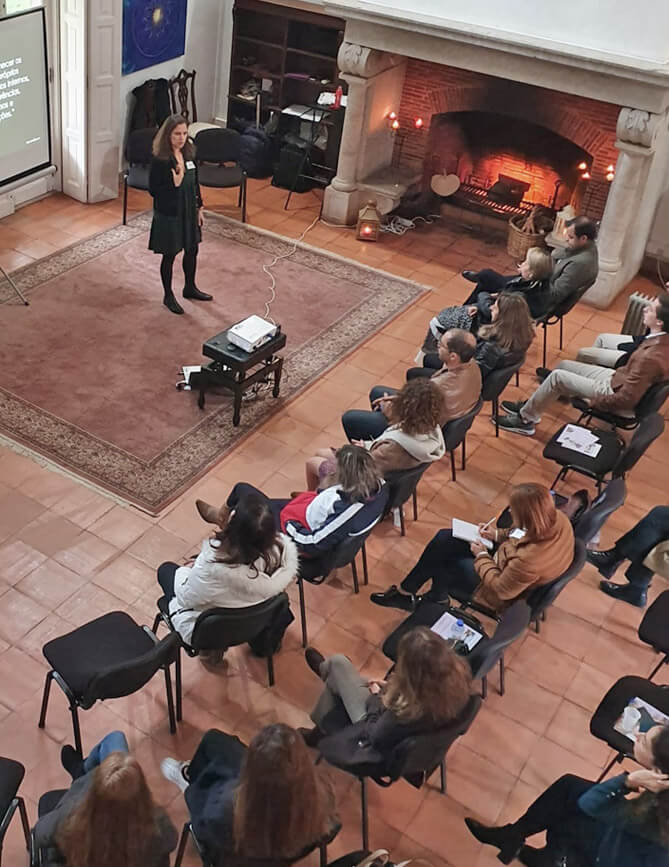Mindfulness is an attitude, a way of being in life (in all its dimensions) and, therefore, it is also a personal and individual decision regardless of the context where we are: at work, at home, on holiday … Knowing this, we also recognize that there are environments that facilitate and block this intention and that the environment at work does not always help us to remain “mindful”.
With that in mind, these are some tips that can help bring Mindfulness into the workplace:
- Define intentions: Being aware and present in every moment is a conscious decision. Make the clear decision to be present as much as possible, either at the beginning of our working day or at the beginning of each task, remembering our intention.
- Eliminate distractions: If our goal is to train our attention, then one of the first steps we can take is to eliminate distractions as much as possible. And if internal distractions are often more difficult to shut down, let us do our best to manage some of the external distractions. As an example, creating time slots without a cell phone, turning off notifications, facilitating spaces of silence or isolation (and communicating our limits).
- Pause: It seems so simple but on our usually busy day we move from one task to another without stopping. So maybe you can try to stop and do nothing; just be, just breathe. Even if it is only for one minute. Small conscious breaks throughout the day can make a difference. Experiment doing them at the beginning and end of the workday, at the beginning of each meeting or phone call, or when moving from one task to another.
- Connect with your senses: Connecting with our senses helps us to avoid ruminating thoughts and to be more “grounded”. Whatever we are doing and especially if we experience many distractions, bringing attention for a moment to our body, and to our five senses, just like that… sight, smell, hearing, taste, touch… in a sequence, one after the other, will help to consciously bring back attention to the present moment.
- Include mindfulness practices: It may be challenging to find a space where you can be in silence and meditate for some minutes. Or even maybe there is no time available to do so. In any case, shorter dedicated practices (micro-practices) can be practice anywhere and take only three breaths. Integrated practices, on the other hand, do not require additional time or extra space and can be done in the work environment.
- Use mindful reminders: Even when our intention is to be more present and attentive to everything we do, it is normal that we forget in our day to day. Repetitive thoughts become our default mental system and, when in daily routines, our body chooses autopilot because it requires less energy. To enjoy the moments more intensely and foster our clarity, creativity and well-being, some reminders can be of help. Examples could be an alarm on the mobile phone; using a mindful app; placing post-it in places that are visible; or using an object, like a watch or a bracelet, that reminds you of the intention.
- Be a single tasker: Several studies carried out in recent years have shown that multitasking is a myth. It is not possible that our attention is focused on two intellectual tasks at the same time. What actually happens is that our attention changes constantly from one task to another, letting us the feeling that we can accomplish several tasks at the same time. But this also has its own set of unintended consequences. Research has shown that it affects our memory in the short term, inhibits creative thinking, creates greater mental strain and anxiety, affects productivity, and increases the likelihood of error. On the other hand, focusing on one task at a time (including not being interrupted by emails or notifications) increases productivity and decreases anxiety.
- Use mindful communication: Usually in our daily work we communicate with several people by phone or in person, alone or in groups, in a more formal or informal way. Conscious communication is one of the practices that we can include in our work routine and, probably, the most impactful one. When talking to someone, choose to deliberately pay attention to what the other person is saying. No previous agenda, no interpretations and judgments, no added stories. Listen carefully, openly, with curiosity. Put your attention on the other but without ever losing track of your own presence so that your communication is also more accurate and effective.
- Use tiny habits: According to B.J. Fogg (founder and director of the Stanford Behaviour Design Lab), to facilitate the creation of a new habit, you associate what you want to start doing (in a very tiny way and with little effort) with an already established routine. As an example, every time my phone rings (routine), I take a deep breath (new habit) before answering. Then, you commit to this new habit during some days, and you celebrate the achievements before you start to enlarge the new habit.
- Find buddies: Sometimes we do not find common interests with co-workers because we do not share ours. By sharing points of view in any regular opportunity, like a coffee conversation, a workshop, or while reading an article in a magazine, we can easily discover that there are others with similar interests, may it be well-being, stress management, or focus… By collaborating with these people, they can become allies and motivating agents for your own mindful intentions. Eventually, who knows, even you all can take advantage of the opportunity and integrate mindfulness in the culture of your organization.

